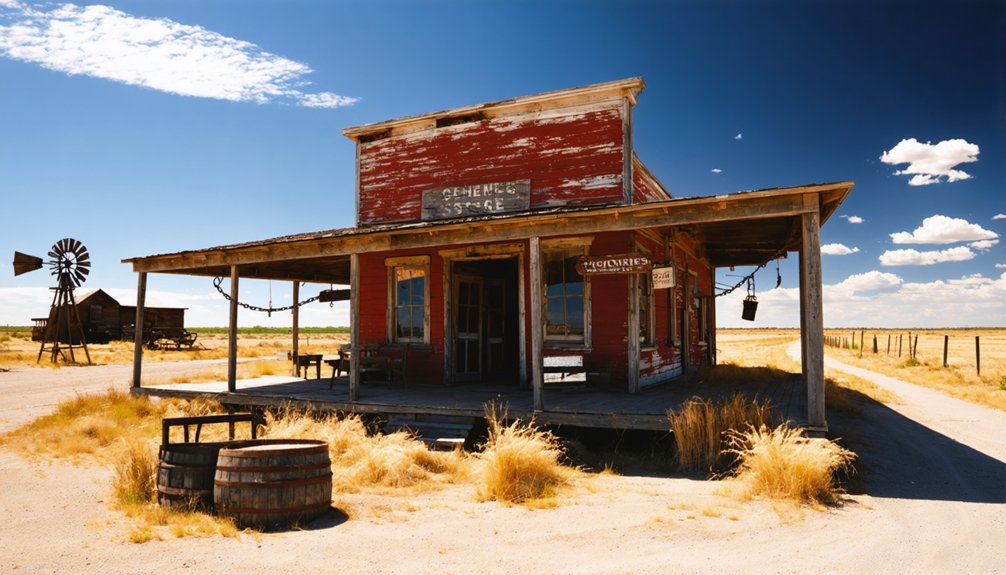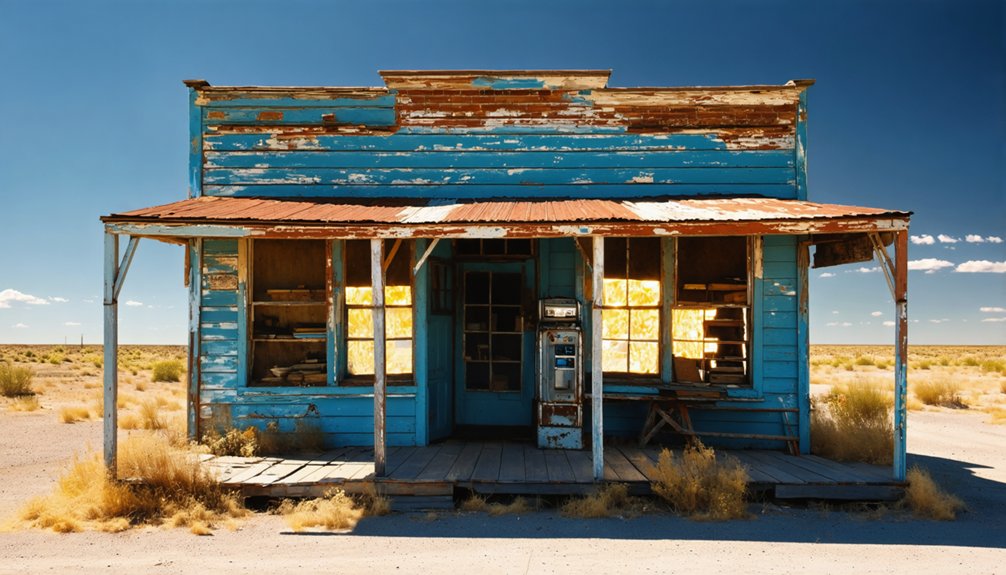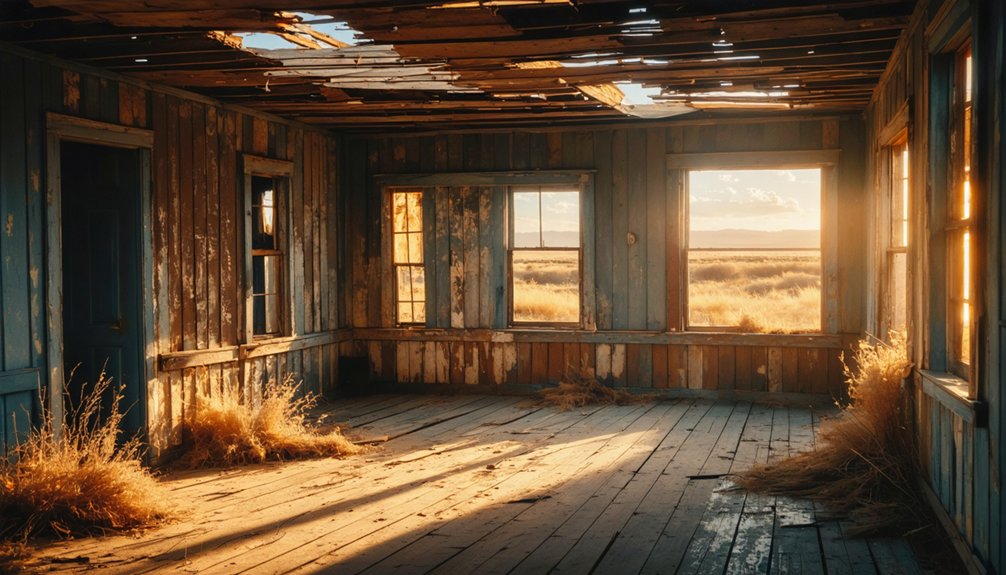You’ll find Slide, Texas tucked away in Lubbock County, where pioneers established homesteads in the 1890s. The settlement got its unique name from a dramatic landslide that shifted the entire townsite, leading to a 1903 resurvey that revealed homes were built two miles off their intended claims. Once a thriving farming community known for cotton production, Slide’s population dwindled as families moved toward Lubbock’s growing opportunities. The untouched pioneer structures and agricultural remnants hold fascinating stories of frontier life.
Key Takeaways
- Slide, Texas became a ghost town after a 1903 land resurvey revealed homes were built two miles away from intended claims.
- Named after a dramatic landslide that shifted the townsite, Slide was originally established by pioneers in the 1890s.
- The community thrived as a farming settlement until railroads bypassed the area, leading to economic decline and population loss.
- Most residents relocated to nearby Lubbock, which grew rapidly after 1909 due to railway connections and economic opportunities.
- The abandoned settlement now offers archaeological opportunities with untouched pioneer structures and agricultural remnants.
Early Settlement and Pioneer Days
As pioneers ventured into the rolling prairies of what would become Slide, Texas in the 1890s, they established homesteads that would shape the region’s early development.
You’ll find that these early settlers faced pioneer challenges like building log cabins and cultivating the land while adapting their Southern farming knowledge to Texas frontier conditions.
Their settlement strategies weren’t always perfect – a 1903 resurvey by W.R. Standefer revealed many had built their homes two miles off their intended claims.
Like the settlers of Eldridge, they constructed a community dispensary to serve the medical needs of local families.
Families like the Prestons from Georgia and Thomas Baker from Mississippi joined others in creating a tight-knit community where cooperation was essential for survival.
They’d establish general stores, work together in farming and ranching, and lay the groundwork for what they hoped would become a thriving town.
Much like in Cheapside, these hardy settlers focused on establishing a robust cotton-based economy that would sustain their growing community.
The Story Behind the Name
The dramatic landslide that physically shifted Slide’s townsite in the early 1900s gave this West Texas settlement its distinctive name.
You’ll find this name uniquely reflects the geological challenges early settlers faced, rather than honoring a founder or cultural heritage. The landslide impact was so significant that a 1903 resurvey by W.R. Standefer revealed settlers’ property claims were off by two miles.
Unlike other Texas towns named for railroad magnates or indigenous terms, Slide’s identity emerged from nature’s raw power. Much like the town of Thurber that became a ghost town by 1930, Slide’s fate was sealed by environmental forces beyond human control.
The unstable terrain shaped not just the physical landscape but the community’s entire character. Like the once-thriving port of Indianola, which was destroyed by two devastating hurricanes, nature demonstrated its ability to reshape Texas settlements.
Today, when you explore Texas ghost towns, you’ll discover that Slide’s name stands as a symbol of the environmental forces that ultimately influenced its destiny.
Agricultural Heritage and Community Life
Despite its eventual decline, Slide flourished as a vibrant farming community where cotton reigned supreme across sprawling fields of the Texas High Plains.
You’d have found farmers using dryland techniques to coax crops from the semi-arid soil, while small-scale ranching provided additional income for resourceful residents.
Community resilience shone through in the way families banded together, sharing labor during planting and harvest seasons.
Like the Native American tribes before them, residents relied heavily on the land’s natural resources for their sustenance.
Your social life would’ve revolved around the local school and church, where gatherings strengthened bonds between neighbors.
The town experienced boom years when the railroad shipping enabled farmers to transport cotton, grain and livestock more efficiently.
Farming practices adapted to nature’s rhythms, with horse-drawn equipment working the land before mechanization arrived.
Local mercantile stores served as trading hubs, while communal wells and grain storage facilities supported the agricultural way of life that defined Slide’s character.
Relocation and Its Impact
While farming life defined Slide’s early character, inaccurate mapping and a fateful 1903 resurvey revealed a stark reality – most settlers had built their homes two miles away from their legally claimed locations.
The relocation effects rippled through the community as railroads bypassed the town, leaving Slide disconnected from essential transportation networks. You’d have witnessed mounting economic challenges as businesses shuttered and families drifted toward Lubbock’s promising opportunities. This decline mirrored the fate of New Birmingham’s industrial dreams, which also failed to materialize due to financial difficulties.
Property values plummeted while abandoned buildings fell into disrepair. The town’s infrastructure crumbled as tax revenues dried up, and agricultural mechanization reduced the need for farm labor.
The Rise of Lubbock’s Influence
As Lubbock grew into a major economic force following its 1909 incorporation, you’d have witnessed the Santa Fe Railway transforming the city into a bustling transportation hub that drew residents away from smaller communities like Slide.
You could trace Lubbock’s magnetic pull through its expanding network of rail lines and highways, which cemented its position as the region’s commercial nucleus. The city’s current financial sector provides over 8,200 jobs, making it one of the region’s fastest-growing industries.
The city’s rapid population growth, doubling from 2,000 to 4,000 between 1910 and 1920, reflected its emerging dominance as people migrated from rural settlements toward greater economic opportunities in the “Hub City.” The establishment of Texas Technological College in 1923 further solidified Lubbock’s role as the region’s educational and cultural center.
Growing Regional Economic Hub
Since becoming a regional powerhouse in West Texas, Lubbock’s economic influence has transformed the area into a thriving metropolitan hub.
You’ll find an impressive economic diversification with GDP growth exceeding 30% between 2019 and 2023, reaching $19.7 billion. The city’s not just about agriculture anymore – it’s branching into education, health services, and renewable energy markets. Local initiatives like South Plains College’s Drone Program showcase the city’s commitment to innovative workforce training.
Through strategic workforce development initiatives, you’re seeing a remarkable 40% employment increase from 2006 to 2025, outpacing both state and national averages.
The city’s expanding its reach by fostering partnerships with surrounding communities and aligning education with industry demands.
Whether you’re in professional services, healthcare, or emerging tech sectors, Lubbock’s creating opportunities that extend well beyond its city limits.
Transportation Networks Expand
During the early 1900s, Lubbock’s transportation revolution began with the arrival of BNSF predecessor lines, transforming the region’s connectivity and economic prospects.
You’d have witnessed the transportation evolution unfold as the first tracks stretched from Plainview to Lubbock in 1910, followed by essential connections to Coleman that opened trade routes to Houston and Galveston ports.
The rail expansion didn’t stop there. By the late 1960s, you’d see Interstate 27 take shape, adding another layer to Lubbock’s growing infrastructure.
When construction wrapped up in the early 1990s, it cemented Lubbock’s position as a key transit hub.
The city’s forward momentum continued into the 21st century with thorough transportation planning and ERCOT integration, ensuring you’d have access to competitive energy markets and reliable infrastructure.
Population Migration Patterns
While smaller towns across West Texas struggled to maintain their populations, Lubbock’s steady growth transformed it into the region’s dominant urban center.
The demographic shifts tell a compelling story – you’ll find a city that grew by over 12% between 2010 and 2020, reaching 257,141 residents while surrounding communities faced rural decline.
The numbers paint a clear picture of why people are choosing Lubbock. With median home values around $152,800 and average rents under $1,000, it’s still affordable to put down roots here.
The city’s young median age of 30-31 reflects its appeal to working families and recent graduates. You’ll see this momentum continuing as Lubbock’s economic opportunities, particularly in healthcare, education, and agriculture, keep drawing people from fading small towns across the region.
From Thriving Town to Ghost Status

Once a flourishing agricultural settlement in Lubbock County, Slide, Texas followed the familiar path of many rural communities that couldn’t withstand the test of time.
The town’s community dynamics revolved around cotton and wheat production, with local businesses serving the needs of hardworking farming families. As economic shifts swept through Texas, younger generations sought opportunities in urban centers, leading to Slide’s gradual decline.
Like countless farming towns before it, Slide’s destiny was sealed when its children traded cotton fields for city lights.
- You can almost hear the echoes of bustling general stores that once served determined settlers.
- Fields that once flourished with cotton and wheat now stand as silent witnesses.
- Family homes, built with hope and determination, slowly faded into the Texas landscape.
- The spirit of independence that drew pioneers remains in the wind-swept prairies.
- Time has erased most physical traces, but Slide’s story lives on in regional history.
Legacy in Lubbock County History
The pioneering spirit of Slide, Texas has left five enduring marks on Lubbock County’s historical tapestry.
You’ll find its legacy in the patterns of early settlement, where brave settlers established one of the county’s oldest communities.
Slide’s commitment to educational institutions began with a humble schoolhouse built from Colorado City lumber, setting a precedent for cultural continuity that persists through today’s Lubbock-Cooper Independent School District.
You can trace the community’s resilience through its ability to adapt to major changes, from the 1903 land survey shift to the broader economic transformations of West Texas.
Though its population has dwindled to fewer than 50 residents, Slide’s historical significance endures as a reflection of the rugged determination of frontier life.
Preservation and Historical Significance

When you explore Slide’s pioneer settlement heritage, you’ll find a remarkably untouched snapshot of early Lubbock County life, preserved through minimal intervention and natural weathering.
The town’s agricultural legacy remains documented through its remaining structures and field patterns, offering historians valuable insights into early farming practices and community development.
Local archaeological opportunities abound in Slide’s undisturbed grounds, where careful examination could reveal artifacts and structural elements that tell the story of Texas frontier life.
Pioneer Settlement Heritage Focus
Nestled thirteen miles southwest of Lubbock, Slide’s pioneer heritage stands as a tribute to late 19th-century Texas settlement patterns and westward expansion.
You’ll discover a reflection of pioneer resilience in this former Block Twenty community, where ranchers and farmers carved out their lives in the semi-arid High Plains.
Through community gatherings, early settlers forged bonds that shaped the social fabric of this remarkable place.
- Feel the echoes of pioneer footsteps along the old farm roads that once buzzed with trade and commerce
- Experience the raw determination of early settlers through preserved oral histories and cultural traditions
- Marvel at the surviving landmarks that tell tales of agricultural innovation and adaptation
- Connect with the spirit of frontier education in the remnants of early schoolhouses
- Walk through the peaceful cemeteries where pioneer stories rest beneath the Texas sky
Agricultural Legacy Documentation
Documenting Slide’s agricultural heritage reveals three pivotal elements of its identity: the 1890s Block Twenty settlement pattern, the prevalence of 150-acre family farms, and the evolution of dryland cotton cultivation.
You’ll find remnants of agricultural practices that shaped this Texas Plains community scattered across the landscape. The surviving heritage structures – weathered barns, granaries, and cotton gins – tell the story of a once-thriving farming settlement.
These buildings showcase traditional construction methods adapted to local conditions, though many have succumbed to time and abandonment.
While formal preservation efforts remain limited, you can still trace Slide’s original farm-to-market routes that connected local cotton and livestock to Lubbock’s broader markets.
The town’s shift from bustling agricultural center to ghost town mirrors the larger story of rural Texas communities transformed by mechanization and changing markets.
Local Archaeological Opportunities
Throughout Slide’s rugged terrain, you’ll discover a wealth of archaeological treasures that paint a vivid picture of early 20th-century life in West Texas.
Despite preservation challenges, the site offers rich opportunities for archaeological digs, from examining mine shafts to studying immigrant craftsmanship in brick masonry and iron work.
The scattered building foundations and cemetery markers tell stories of the diverse communities who once called this place home.
- Stand at the edge of time as you explore protected mine shafts with original timber frames
- Trace the lives of Polish, Italian, British, and Irish immigrants through their skilled stonework
- Walk among the weathered headstones that whisper tales of frontier families
- Uncover the technological innovations of early mining operations in waste rock formations
- Experience the untamed spirit of Texas boomtown culture in every artifact
Frequently Asked Questions
What Is the Current Population of Slide, Texas Today?
You’ll find current demographics indicate a near-zero permanent population today, as population trends show Slide joining many Texas ghost towns where residents have moved away seeking opportunities elsewhere.
Are There Any Remaining Buildings or Structures Still Standing in Slide?
You won’t find any significant standing structures in this ghost town today. Historical records and recent surveys indicate that virtually all original buildings have disappeared, leaving only scattered remnants and foundations behind.
When Was the Last Operating Business in Slide Officially Closed?
You’d think someone would’ve kept a diary marking that final business closure in Slide’s history, but unfortunately, there’s no official record of when the last enterprise shut its doors.
Can Visitors Access the Original and Relocated Sites of Slide?
You can access the original site near FM 1730 and 41 since it’s public roadway, but there’s no relocated ghost town site of historical significance to visit.
Were There Any Notable Historical Figures or Events Associated With Slide?
You won’t find any prominent historical figures linked to Slide’s past. Historical importance centered mainly on coal mining operations, and while local residents contributed to the community, none achieved widespread recognition.
References
- https://www.youtube.com/watch?v=phjUE19A8HM
- https://www.youtube.com/watch?v=UniG4FbRwaw
- https://www.hipcamp.com/journal/camping/texas-ghost-towns/
- https://texashighways.com/travel-news/four-texas-ghost-towns/
- https://www.texasescapes.com/TexasTowns/Slide-Texas.htm
- https://en.wikipedia.org/wiki/List_of_ghost_towns_in_Texas
- https://texashistory.unt.edu/ark:/67531/metapth87310/
- https://texasescapes.com/TexasGhostTowns/Sligo-Texas.htm
- https://www.tshaonline.org/handbook/entries/slide-tx
- https://theforgottensouth.com/cheapside-texas-ghost-town-history/



